Business Finance Report: Cash Flow, Budgeting, and Management
VerifiedAdded on 2023/01/18
|10
|2733
|75
Report
AI Summary
This report delves into the core concepts of business finance, commencing with a comparison of profit and cash flow. It examines working capital, encompassing payables, inventory, and receivables, and how changes in these elements influence a company's cash flow. The report then explores how management practices affect financial outcomes, particularly focusing on a case study of Bright Lawns Ltd. It provides recommendations for enhancing cash flow through effective working capital management. Furthermore, the report explains the purpose of budgeting and contrasts traditional and alternative budgetary systems, such as zero-based budgeting. The analysis extends to how companies can leverage these methods for future cost management, concluding with a recommendation for Boat World Plc to adopt zero-based budgeting to improve cost savings and manage debts effectively. The report uses examples from the case studies to illustrate the application of financial principles.
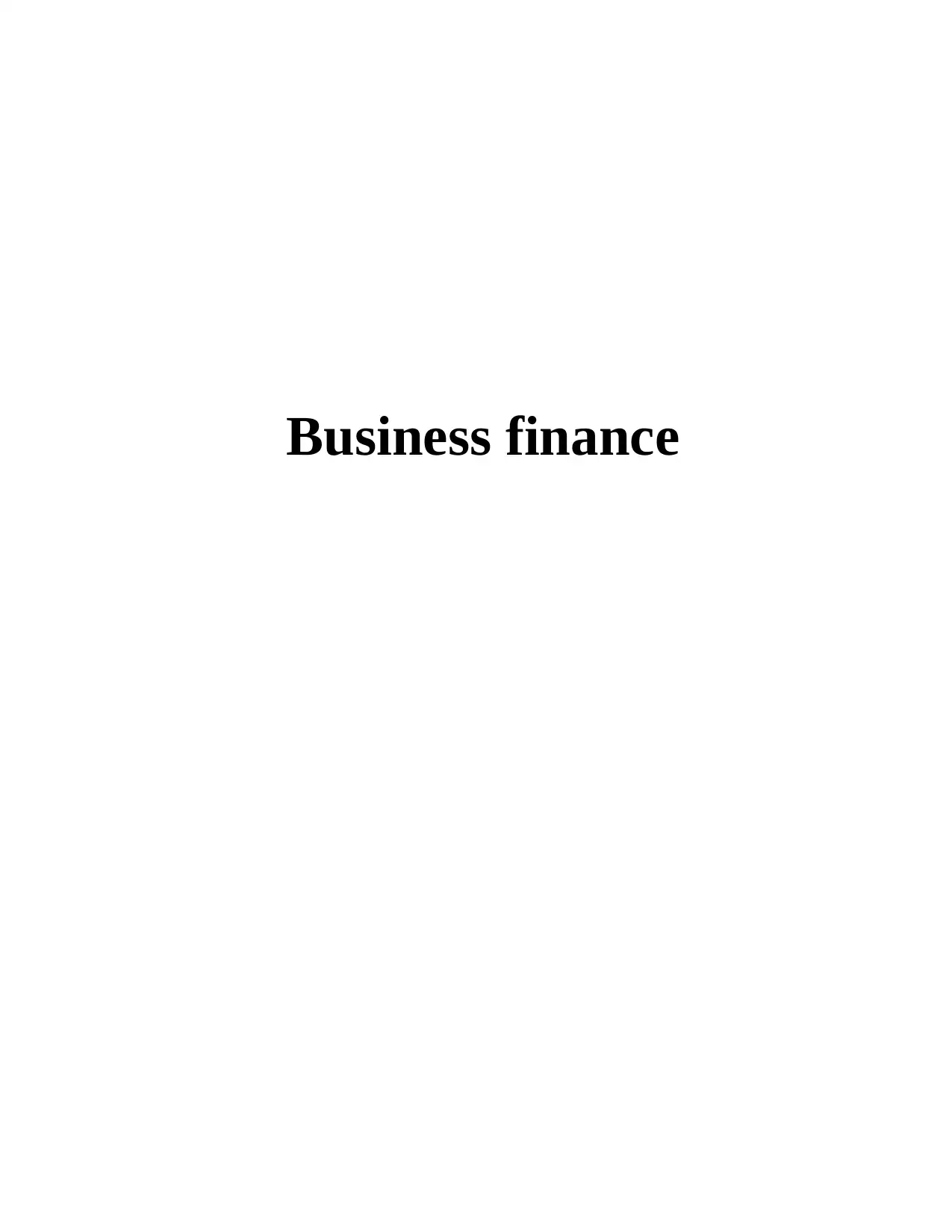
Business finance
Paraphrase This Document
Need a fresh take? Get an instant paraphrase of this document with our AI Paraphraser
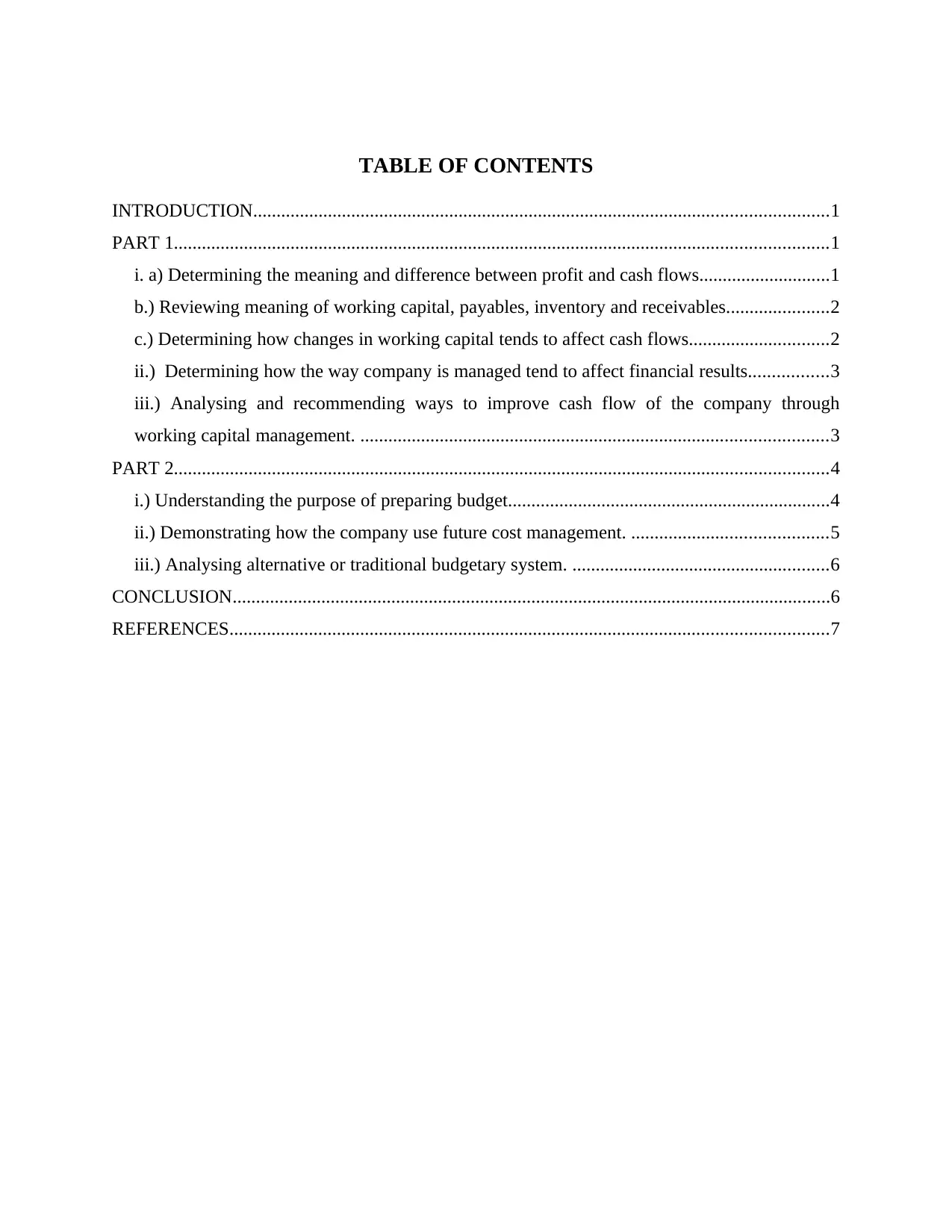
TABLE OF CONTENTS
INTRODUCTION...........................................................................................................................1
PART 1............................................................................................................................................1
i. a) Determining the meaning and difference between profit and cash flows............................1
b.) Reviewing meaning of working capital, payables, inventory and receivables......................2
c.) Determining how changes in working capital tends to affect cash flows..............................2
ii.) Determining how the way company is managed tend to affect financial results.................3
iii.) Analysing and recommending ways to improve cash flow of the company through
working capital management. ....................................................................................................3
PART 2............................................................................................................................................4
i.) Understanding the purpose of preparing budget.....................................................................4
ii.) Demonstrating how the company use future cost management. ..........................................5
iii.) Analysing alternative or traditional budgetary system. .......................................................6
CONCLUSION................................................................................................................................6
REFERENCES................................................................................................................................7
INTRODUCTION...........................................................................................................................1
PART 1............................................................................................................................................1
i. a) Determining the meaning and difference between profit and cash flows............................1
b.) Reviewing meaning of working capital, payables, inventory and receivables......................2
c.) Determining how changes in working capital tends to affect cash flows..............................2
ii.) Determining how the way company is managed tend to affect financial results.................3
iii.) Analysing and recommending ways to improve cash flow of the company through
working capital management. ....................................................................................................3
PART 2............................................................................................................................................4
i.) Understanding the purpose of preparing budget.....................................................................4
ii.) Demonstrating how the company use future cost management. ..........................................5
iii.) Analysing alternative or traditional budgetary system. .......................................................6
CONCLUSION................................................................................................................................6
REFERENCES................................................................................................................................7
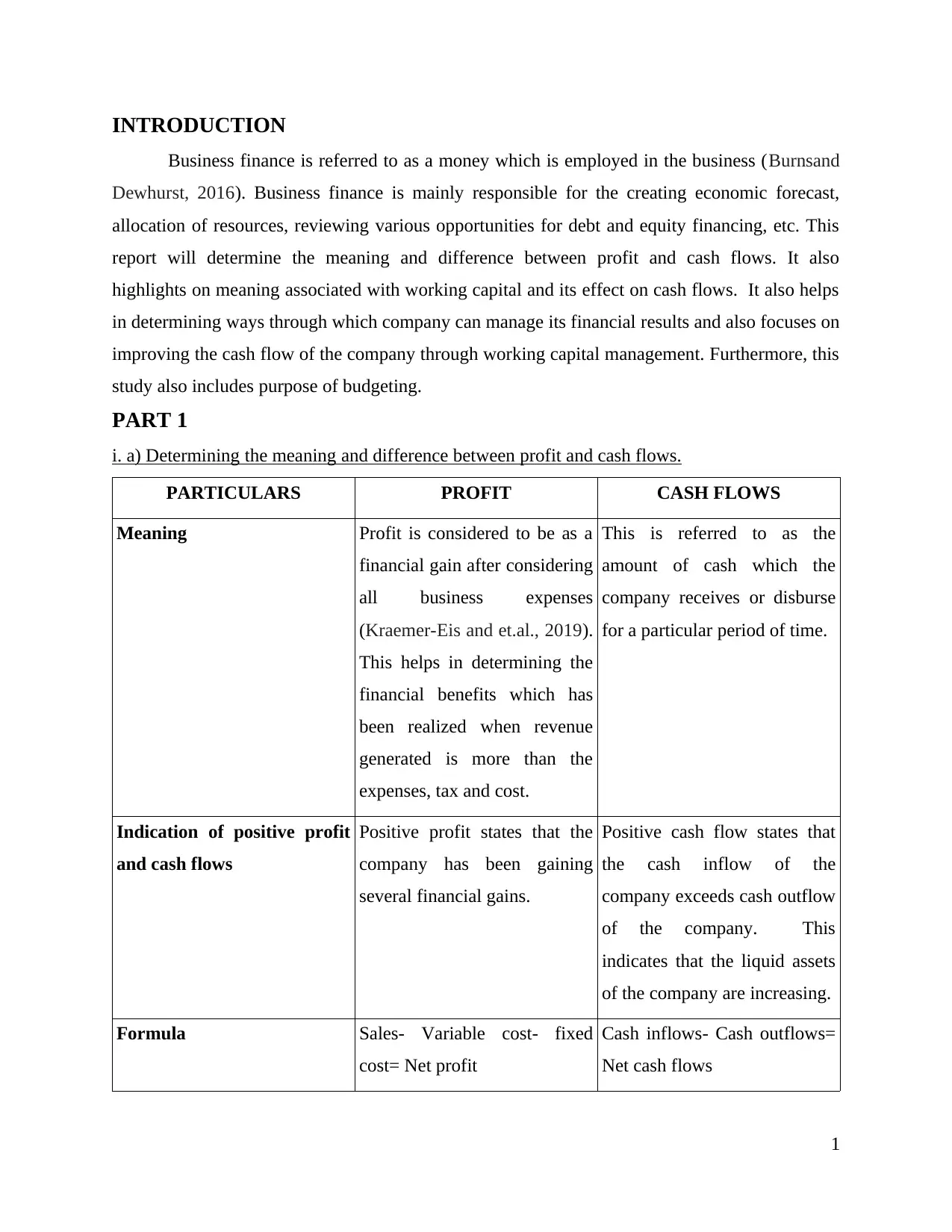
INTRODUCTION
Business finance is referred to as a money which is employed in the business (Burnsand
Dewhurst, 2016). Business finance is mainly responsible for the creating economic forecast,
allocation of resources, reviewing various opportunities for debt and equity financing, etc. This
report will determine the meaning and difference between profit and cash flows. It also
highlights on meaning associated with working capital and its effect on cash flows. It also helps
in determining ways through which company can manage its financial results and also focuses on
improving the cash flow of the company through working capital management. Furthermore, this
study also includes purpose of budgeting.
PART 1
i. a) Determining the meaning and difference between profit and cash flows.
PARTICULARS PROFIT CASH FLOWS
Meaning Profit is considered to be as a
financial gain after considering
all business expenses
(Kraemer-Eis and et.al., 2019).
This helps in determining the
financial benefits which has
been realized when revenue
generated is more than the
expenses, tax and cost.
This is referred to as the
amount of cash which the
company receives or disburse
for a particular period of time.
Indication of positive profit
and cash flows
Positive profit states that the
company has been gaining
several financial gains.
Positive cash flow states that
the cash inflow of the
company exceeds cash outflow
of the company. This
indicates that the liquid assets
of the company are increasing.
Formula Sales- Variable cost- fixed
cost= Net profit
Cash inflows- Cash outflows=
Net cash flows
1
Business finance is referred to as a money which is employed in the business (Burnsand
Dewhurst, 2016). Business finance is mainly responsible for the creating economic forecast,
allocation of resources, reviewing various opportunities for debt and equity financing, etc. This
report will determine the meaning and difference between profit and cash flows. It also
highlights on meaning associated with working capital and its effect on cash flows. It also helps
in determining ways through which company can manage its financial results and also focuses on
improving the cash flow of the company through working capital management. Furthermore, this
study also includes purpose of budgeting.
PART 1
i. a) Determining the meaning and difference between profit and cash flows.
PARTICULARS PROFIT CASH FLOWS
Meaning Profit is considered to be as a
financial gain after considering
all business expenses
(Kraemer-Eis and et.al., 2019).
This helps in determining the
financial benefits which has
been realized when revenue
generated is more than the
expenses, tax and cost.
This is referred to as the
amount of cash which the
company receives or disburse
for a particular period of time.
Indication of positive profit
and cash flows
Positive profit states that the
company has been gaining
several financial gains.
Positive cash flow states that
the cash inflow of the
company exceeds cash outflow
of the company. This
indicates that the liquid assets
of the company are increasing.
Formula Sales- Variable cost- fixed
cost= Net profit
Cash inflows- Cash outflows=
Net cash flows
1
⊘ This is a preview!⊘
Do you want full access?
Subscribe today to unlock all pages.

Trusted by 1+ million students worldwide
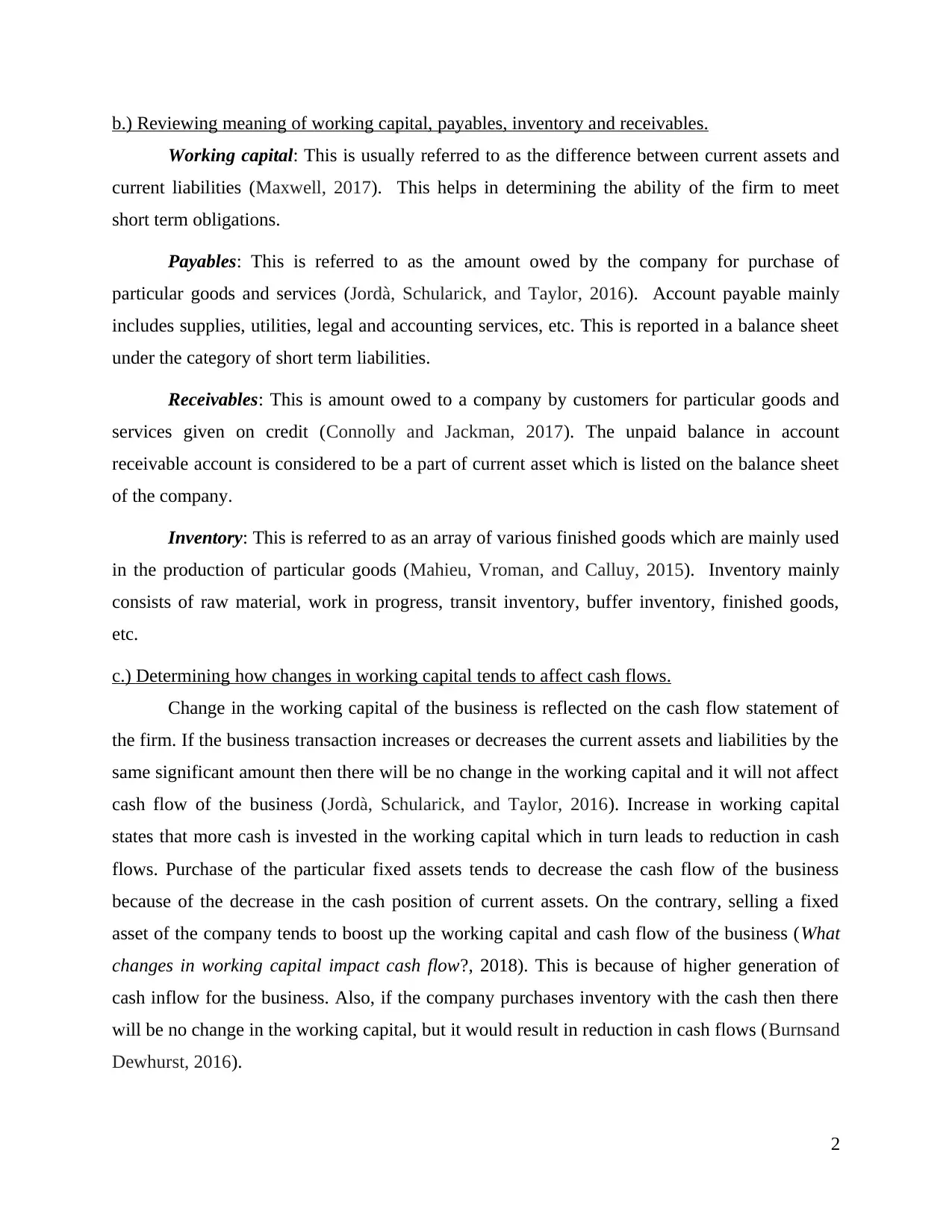
b.) Reviewing meaning of working capital, payables, inventory and receivables.
Working capital: This is usually referred to as the difference between current assets and
current liabilities (Maxwell, 2017). This helps in determining the ability of the firm to meet
short term obligations.
Payables: This is referred to as the amount owed by the company for purchase of
particular goods and services (Jordà, Schularick, and Taylor, 2016). Account payable mainly
includes supplies, utilities, legal and accounting services, etc. This is reported in a balance sheet
under the category of short term liabilities.
Receivables: This is amount owed to a company by customers for particular goods and
services given on credit (Connolly and Jackman, 2017). The unpaid balance in account
receivable account is considered to be a part of current asset which is listed on the balance sheet
of the company.
Inventory: This is referred to as an array of various finished goods which are mainly used
in the production of particular goods (Mahieu, Vroman, and Calluy, 2015). Inventory mainly
consists of raw material, work in progress, transit inventory, buffer inventory, finished goods,
etc.
c.) Determining how changes in working capital tends to affect cash flows.
Change in the working capital of the business is reflected on the cash flow statement of
the firm. If the business transaction increases or decreases the current assets and liabilities by the
same significant amount then there will be no change in the working capital and it will not affect
cash flow of the business (Jordà, Schularick, and Taylor, 2016). Increase in working capital
states that more cash is invested in the working capital which in turn leads to reduction in cash
flows. Purchase of the particular fixed assets tends to decrease the cash flow of the business
because of the decrease in the cash position of current assets. On the contrary, selling a fixed
asset of the company tends to boost up the working capital and cash flow of the business (What
changes in working capital impact cash flow?, 2018). This is because of higher generation of
cash inflow for the business. Also, if the company purchases inventory with the cash then there
will be no change in the working capital, but it would result in reduction in cash flows (Burnsand
Dewhurst, 2016).
2
Working capital: This is usually referred to as the difference between current assets and
current liabilities (Maxwell, 2017). This helps in determining the ability of the firm to meet
short term obligations.
Payables: This is referred to as the amount owed by the company for purchase of
particular goods and services (Jordà, Schularick, and Taylor, 2016). Account payable mainly
includes supplies, utilities, legal and accounting services, etc. This is reported in a balance sheet
under the category of short term liabilities.
Receivables: This is amount owed to a company by customers for particular goods and
services given on credit (Connolly and Jackman, 2017). The unpaid balance in account
receivable account is considered to be a part of current asset which is listed on the balance sheet
of the company.
Inventory: This is referred to as an array of various finished goods which are mainly used
in the production of particular goods (Mahieu, Vroman, and Calluy, 2015). Inventory mainly
consists of raw material, work in progress, transit inventory, buffer inventory, finished goods,
etc.
c.) Determining how changes in working capital tends to affect cash flows.
Change in the working capital of the business is reflected on the cash flow statement of
the firm. If the business transaction increases or decreases the current assets and liabilities by the
same significant amount then there will be no change in the working capital and it will not affect
cash flow of the business (Jordà, Schularick, and Taylor, 2016). Increase in working capital
states that more cash is invested in the working capital which in turn leads to reduction in cash
flows. Purchase of the particular fixed assets tends to decrease the cash flow of the business
because of the decrease in the cash position of current assets. On the contrary, selling a fixed
asset of the company tends to boost up the working capital and cash flow of the business (What
changes in working capital impact cash flow?, 2018). This is because of higher generation of
cash inflow for the business. Also, if the company purchases inventory with the cash then there
will be no change in the working capital, but it would result in reduction in cash flows (Burnsand
Dewhurst, 2016).
2
Paraphrase This Document
Need a fresh take? Get an instant paraphrase of this document with our AI Paraphraser
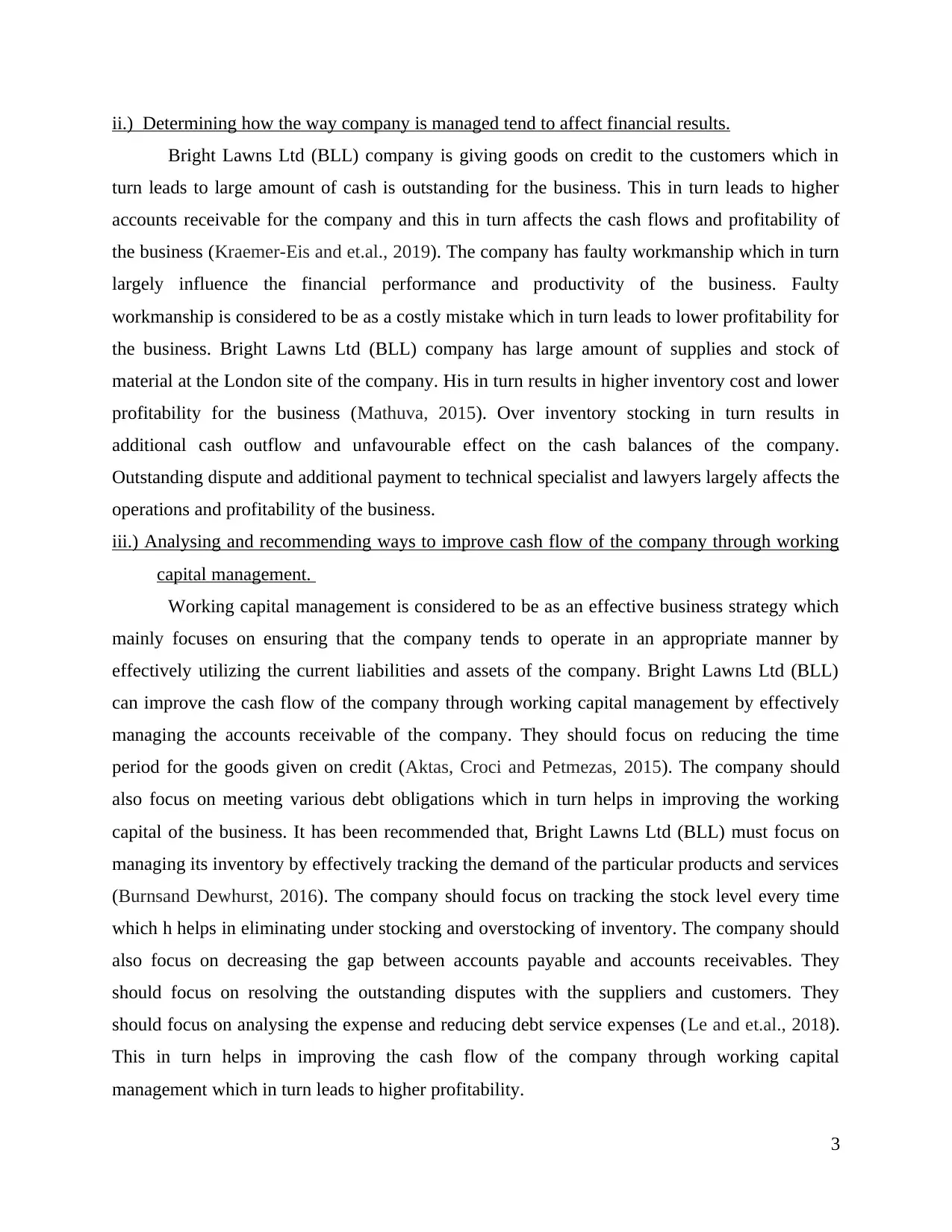
ii.) Determining how the way company is managed tend to affect financial results.
Bright Lawns Ltd (BLL) company is giving goods on credit to the customers which in
turn leads to large amount of cash is outstanding for the business. This in turn leads to higher
accounts receivable for the company and this in turn affects the cash flows and profitability of
the business (Kraemer-Eis and et.al., 2019). The company has faulty workmanship which in turn
largely influence the financial performance and productivity of the business. Faulty
workmanship is considered to be as a costly mistake which in turn leads to lower profitability for
the business. Bright Lawns Ltd (BLL) company has large amount of supplies and stock of
material at the London site of the company. His in turn results in higher inventory cost and lower
profitability for the business (Mathuva, 2015). Over inventory stocking in turn results in
additional cash outflow and unfavourable effect on the cash balances of the company.
Outstanding dispute and additional payment to technical specialist and lawyers largely affects the
operations and profitability of the business.
iii.) Analysing and recommending ways to improve cash flow of the company through working
capital management.
Working capital management is considered to be as an effective business strategy which
mainly focuses on ensuring that the company tends to operate in an appropriate manner by
effectively utilizing the current liabilities and assets of the company. Bright Lawns Ltd (BLL)
can improve the cash flow of the company through working capital management by effectively
managing the accounts receivable of the company. They should focus on reducing the time
period for the goods given on credit (Aktas, Croci and Petmezas, 2015). The company should
also focus on meeting various debt obligations which in turn helps in improving the working
capital of the business. It has been recommended that, Bright Lawns Ltd (BLL) must focus on
managing its inventory by effectively tracking the demand of the particular products and services
(Burnsand Dewhurst, 2016). The company should focus on tracking the stock level every time
which h helps in eliminating under stocking and overstocking of inventory. The company should
also focus on decreasing the gap between accounts payable and accounts receivables. They
should focus on resolving the outstanding disputes with the suppliers and customers. They
should focus on analysing the expense and reducing debt service expenses (Le and et.al., 2018).
This in turn helps in improving the cash flow of the company through working capital
management which in turn leads to higher profitability.
3
Bright Lawns Ltd (BLL) company is giving goods on credit to the customers which in
turn leads to large amount of cash is outstanding for the business. This in turn leads to higher
accounts receivable for the company and this in turn affects the cash flows and profitability of
the business (Kraemer-Eis and et.al., 2019). The company has faulty workmanship which in turn
largely influence the financial performance and productivity of the business. Faulty
workmanship is considered to be as a costly mistake which in turn leads to lower profitability for
the business. Bright Lawns Ltd (BLL) company has large amount of supplies and stock of
material at the London site of the company. His in turn results in higher inventory cost and lower
profitability for the business (Mathuva, 2015). Over inventory stocking in turn results in
additional cash outflow and unfavourable effect on the cash balances of the company.
Outstanding dispute and additional payment to technical specialist and lawyers largely affects the
operations and profitability of the business.
iii.) Analysing and recommending ways to improve cash flow of the company through working
capital management.
Working capital management is considered to be as an effective business strategy which
mainly focuses on ensuring that the company tends to operate in an appropriate manner by
effectively utilizing the current liabilities and assets of the company. Bright Lawns Ltd (BLL)
can improve the cash flow of the company through working capital management by effectively
managing the accounts receivable of the company. They should focus on reducing the time
period for the goods given on credit (Aktas, Croci and Petmezas, 2015). The company should
also focus on meeting various debt obligations which in turn helps in improving the working
capital of the business. It has been recommended that, Bright Lawns Ltd (BLL) must focus on
managing its inventory by effectively tracking the demand of the particular products and services
(Burnsand Dewhurst, 2016). The company should focus on tracking the stock level every time
which h helps in eliminating under stocking and overstocking of inventory. The company should
also focus on decreasing the gap between accounts payable and accounts receivables. They
should focus on resolving the outstanding disputes with the suppliers and customers. They
should focus on analysing the expense and reducing debt service expenses (Le and et.al., 2018).
This in turn helps in improving the cash flow of the company through working capital
management which in turn leads to higher profitability.
3
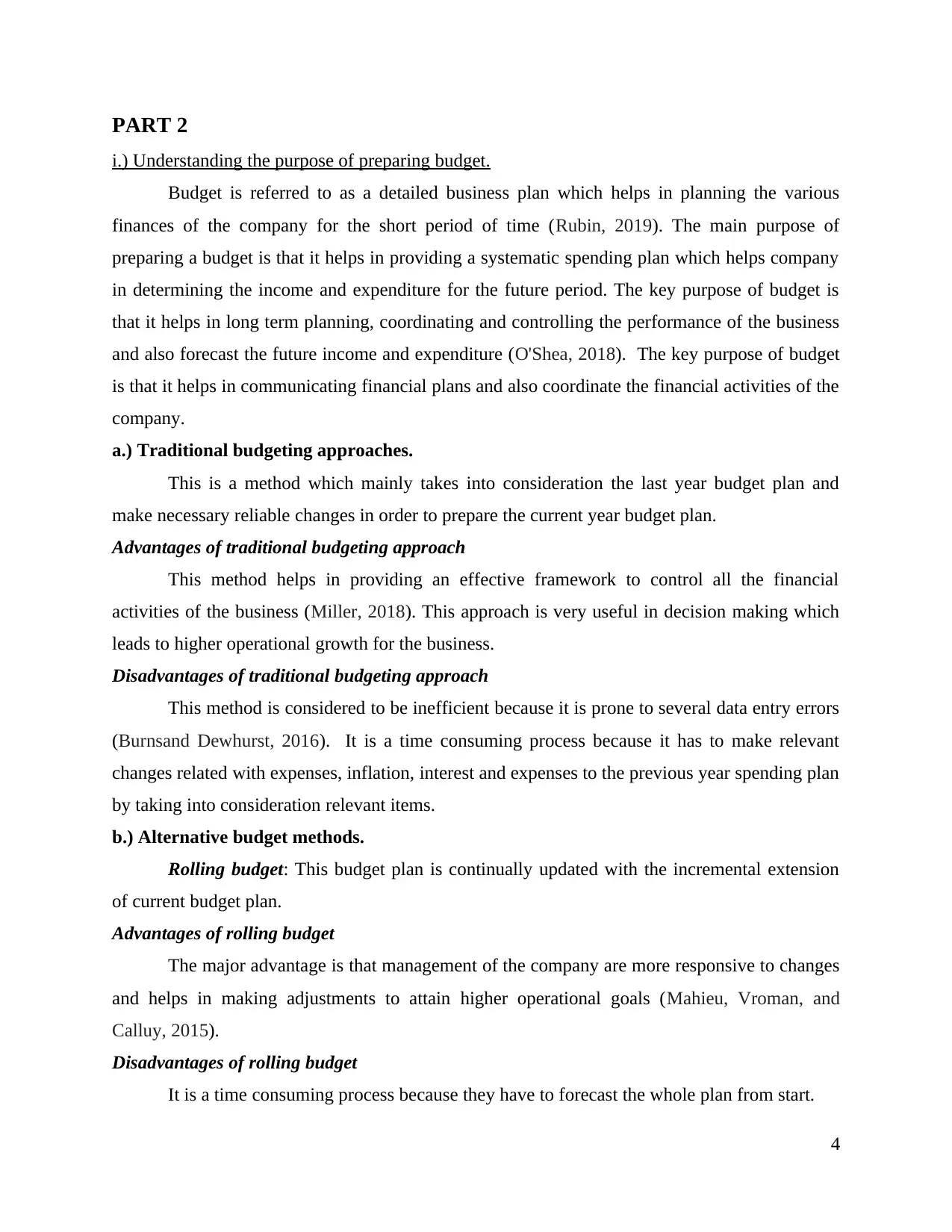
PART 2
i.) Understanding the purpose of preparing budget.
Budget is referred to as a detailed business plan which helps in planning the various
finances of the company for the short period of time (Rubin, 2019). The main purpose of
preparing a budget is that it helps in providing a systematic spending plan which helps company
in determining the income and expenditure for the future period. The key purpose of budget is
that it helps in long term planning, coordinating and controlling the performance of the business
and also forecast the future income and expenditure (O'Shea, 2018). The key purpose of budget
is that it helps in communicating financial plans and also coordinate the financial activities of the
company.
a.) Traditional budgeting approaches.
This is a method which mainly takes into consideration the last year budget plan and
make necessary reliable changes in order to prepare the current year budget plan.
Advantages of traditional budgeting approach
This method helps in providing an effective framework to control all the financial
activities of the business (Miller, 2018). This approach is very useful in decision making which
leads to higher operational growth for the business.
Disadvantages of traditional budgeting approach
This method is considered to be inefficient because it is prone to several data entry errors
(Burnsand Dewhurst, 2016). It is a time consuming process because it has to make relevant
changes related with expenses, inflation, interest and expenses to the previous year spending plan
by taking into consideration relevant items.
b.) Alternative budget methods.
Rolling budget: This budget plan is continually updated with the incremental extension
of current budget plan.
Advantages of rolling budget
The major advantage is that management of the company are more responsive to changes
and helps in making adjustments to attain higher operational goals (Mahieu, Vroman, and
Calluy, 2015).
Disadvantages of rolling budget
It is a time consuming process because they have to forecast the whole plan from start.
4
i.) Understanding the purpose of preparing budget.
Budget is referred to as a detailed business plan which helps in planning the various
finances of the company for the short period of time (Rubin, 2019). The main purpose of
preparing a budget is that it helps in providing a systematic spending plan which helps company
in determining the income and expenditure for the future period. The key purpose of budget is
that it helps in long term planning, coordinating and controlling the performance of the business
and also forecast the future income and expenditure (O'Shea, 2018). The key purpose of budget
is that it helps in communicating financial plans and also coordinate the financial activities of the
company.
a.) Traditional budgeting approaches.
This is a method which mainly takes into consideration the last year budget plan and
make necessary reliable changes in order to prepare the current year budget plan.
Advantages of traditional budgeting approach
This method helps in providing an effective framework to control all the financial
activities of the business (Miller, 2018). This approach is very useful in decision making which
leads to higher operational growth for the business.
Disadvantages of traditional budgeting approach
This method is considered to be inefficient because it is prone to several data entry errors
(Burnsand Dewhurst, 2016). It is a time consuming process because it has to make relevant
changes related with expenses, inflation, interest and expenses to the previous year spending plan
by taking into consideration relevant items.
b.) Alternative budget methods.
Rolling budget: This budget plan is continually updated with the incremental extension
of current budget plan.
Advantages of rolling budget
The major advantage is that management of the company are more responsive to changes
and helps in making adjustments to attain higher operational goals (Mahieu, Vroman, and
Calluy, 2015).
Disadvantages of rolling budget
It is a time consuming process because they have to forecast the whole plan from start.
4
⊘ This is a preview!⊘
Do you want full access?
Subscribe today to unlock all pages.

Trusted by 1+ million students worldwide
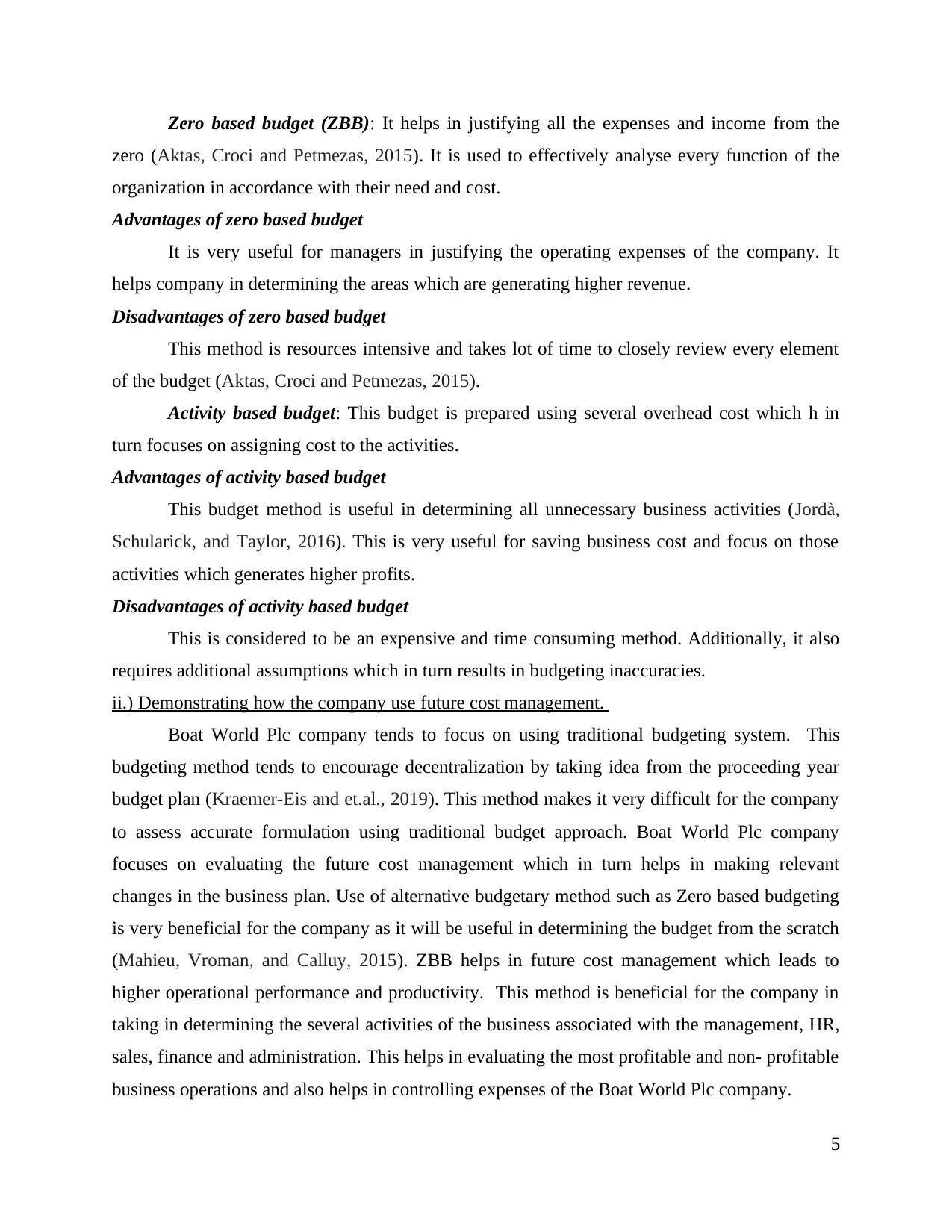
Zero based budget (ZBB): It helps in justifying all the expenses and income from the
zero (Aktas, Croci and Petmezas, 2015). It is used to effectively analyse every function of the
organization in accordance with their need and cost.
Advantages of zero based budget
It is very useful for managers in justifying the operating expenses of the company. It
helps company in determining the areas which are generating higher revenue.
Disadvantages of zero based budget
This method is resources intensive and takes lot of time to closely review every element
of the budget (Aktas, Croci and Petmezas, 2015).
Activity based budget: This budget is prepared using several overhead cost which h in
turn focuses on assigning cost to the activities.
Advantages of activity based budget
This budget method is useful in determining all unnecessary business activities (Jordà,
Schularick, and Taylor, 2016). This is very useful for saving business cost and focus on those
activities which generates higher profits.
Disadvantages of activity based budget
This is considered to be an expensive and time consuming method. Additionally, it also
requires additional assumptions which in turn results in budgeting inaccuracies.
ii.) Demonstrating how the company use future cost management.
Boat World Plc company tends to focus on using traditional budgeting system. This
budgeting method tends to encourage decentralization by taking idea from the proceeding year
budget plan (Kraemer-Eis and et.al., 2019). This method makes it very difficult for the company
to assess accurate formulation using traditional budget approach. Boat World Plc company
focuses on evaluating the future cost management which in turn helps in making relevant
changes in the business plan. Use of alternative budgetary method such as Zero based budgeting
is very beneficial for the company as it will be useful in determining the budget from the scratch
(Mahieu, Vroman, and Calluy, 2015). ZBB helps in future cost management which leads to
higher operational performance and productivity. This method is beneficial for the company in
taking in determining the several activities of the business associated with the management, HR,
sales, finance and administration. This helps in evaluating the most profitable and non- profitable
business operations and also helps in controlling expenses of the Boat World Plc company.
5
zero (Aktas, Croci and Petmezas, 2015). It is used to effectively analyse every function of the
organization in accordance with their need and cost.
Advantages of zero based budget
It is very useful for managers in justifying the operating expenses of the company. It
helps company in determining the areas which are generating higher revenue.
Disadvantages of zero based budget
This method is resources intensive and takes lot of time to closely review every element
of the budget (Aktas, Croci and Petmezas, 2015).
Activity based budget: This budget is prepared using several overhead cost which h in
turn focuses on assigning cost to the activities.
Advantages of activity based budget
This budget method is useful in determining all unnecessary business activities (Jordà,
Schularick, and Taylor, 2016). This is very useful for saving business cost and focus on those
activities which generates higher profits.
Disadvantages of activity based budget
This is considered to be an expensive and time consuming method. Additionally, it also
requires additional assumptions which in turn results in budgeting inaccuracies.
ii.) Demonstrating how the company use future cost management.
Boat World Plc company tends to focus on using traditional budgeting system. This
budgeting method tends to encourage decentralization by taking idea from the proceeding year
budget plan (Kraemer-Eis and et.al., 2019). This method makes it very difficult for the company
to assess accurate formulation using traditional budget approach. Boat World Plc company
focuses on evaluating the future cost management which in turn helps in making relevant
changes in the business plan. Use of alternative budgetary method such as Zero based budgeting
is very beneficial for the company as it will be useful in determining the budget from the scratch
(Mahieu, Vroman, and Calluy, 2015). ZBB helps in future cost management which leads to
higher operational performance and productivity. This method is beneficial for the company in
taking in determining the several activities of the business associated with the management, HR,
sales, finance and administration. This helps in evaluating the most profitable and non- profitable
business operations and also helps in controlling expenses of the Boat World Plc company.
5
Paraphrase This Document
Need a fresh take? Get an instant paraphrase of this document with our AI Paraphraser
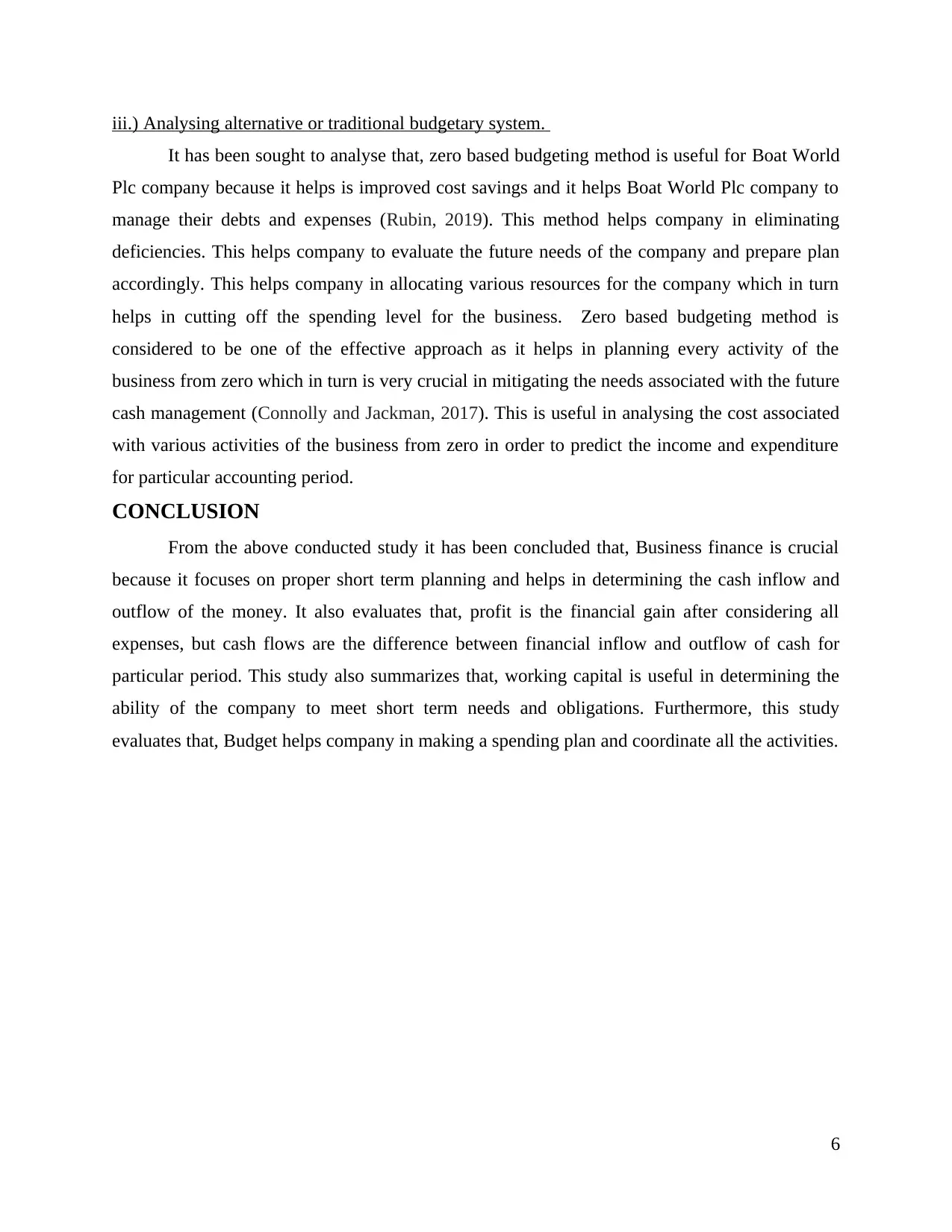
iii.) Analysing alternative or traditional budgetary system.
It has been sought to analyse that, zero based budgeting method is useful for Boat World
Plc company because it helps is improved cost savings and it helps Boat World Plc company to
manage their debts and expenses (Rubin, 2019). This method helps company in eliminating
deficiencies. This helps company to evaluate the future needs of the company and prepare plan
accordingly. This helps company in allocating various resources for the company which in turn
helps in cutting off the spending level for the business. Zero based budgeting method is
considered to be one of the effective approach as it helps in planning every activity of the
business from zero which in turn is very crucial in mitigating the needs associated with the future
cash management (Connolly and Jackman, 2017). This is useful in analysing the cost associated
with various activities of the business from zero in order to predict the income and expenditure
for particular accounting period.
CONCLUSION
From the above conducted study it has been concluded that, Business finance is crucial
because it focuses on proper short term planning and helps in determining the cash inflow and
outflow of the money. It also evaluates that, profit is the financial gain after considering all
expenses, but cash flows are the difference between financial inflow and outflow of cash for
particular period. This study also summarizes that, working capital is useful in determining the
ability of the company to meet short term needs and obligations. Furthermore, this study
evaluates that, Budget helps company in making a spending plan and coordinate all the activities.
6
It has been sought to analyse that, zero based budgeting method is useful for Boat World
Plc company because it helps is improved cost savings and it helps Boat World Plc company to
manage their debts and expenses (Rubin, 2019). This method helps company in eliminating
deficiencies. This helps company to evaluate the future needs of the company and prepare plan
accordingly. This helps company in allocating various resources for the company which in turn
helps in cutting off the spending level for the business. Zero based budgeting method is
considered to be one of the effective approach as it helps in planning every activity of the
business from zero which in turn is very crucial in mitigating the needs associated with the future
cash management (Connolly and Jackman, 2017). This is useful in analysing the cost associated
with various activities of the business from zero in order to predict the income and expenditure
for particular accounting period.
CONCLUSION
From the above conducted study it has been concluded that, Business finance is crucial
because it focuses on proper short term planning and helps in determining the cash inflow and
outflow of the money. It also evaluates that, profit is the financial gain after considering all
expenses, but cash flows are the difference between financial inflow and outflow of cash for
particular period. This study also summarizes that, working capital is useful in determining the
ability of the company to meet short term needs and obligations. Furthermore, this study
evaluates that, Budget helps company in making a spending plan and coordinate all the activities.
6
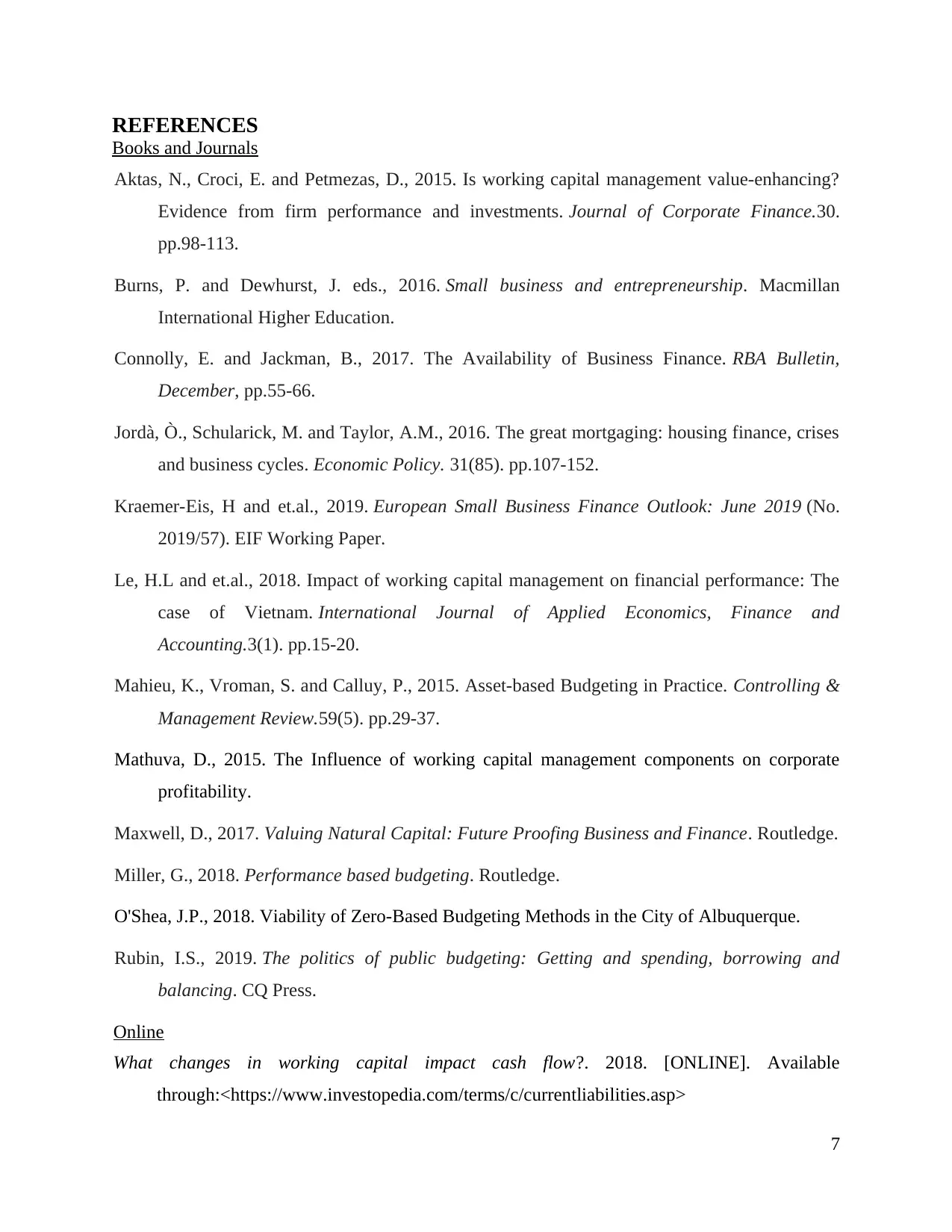
REFERENCES
Books and Journals
Aktas, N., Croci, E. and Petmezas, D., 2015. Is working capital management value-enhancing?
Evidence from firm performance and investments. Journal of Corporate Finance.30.
pp.98-113.
Burns, P. and Dewhurst, J. eds., 2016. Small business and entrepreneurship. Macmillan
International Higher Education.
Connolly, E. and Jackman, B., 2017. The Availability of Business Finance. RBA Bulletin,
December, pp.55-66.
Jordà, Ò., Schularick, M. and Taylor, A.M., 2016. The great mortgaging: housing finance, crises
and business cycles. Economic Policy. 31(85). pp.107-152.
Kraemer-Eis, H and et.al., 2019. European Small Business Finance Outlook: June 2019 (No.
2019/57). EIF Working Paper.
Le, H.L and et.al., 2018. Impact of working capital management on financial performance: The
case of Vietnam. International Journal of Applied Economics, Finance and
Accounting.3(1). pp.15-20.
Mahieu, K., Vroman, S. and Calluy, P., 2015. Asset-based Budgeting in Practice. Controlling &
Management Review.59(5). pp.29-37.
Mathuva, D., 2015. The Influence of working capital management components on corporate
profitability.
Maxwell, D., 2017. Valuing Natural Capital: Future Proofing Business and Finance. Routledge.
Miller, G., 2018. Performance based budgeting. Routledge.
O'Shea, J.P., 2018. Viability of Zero-Based Budgeting Methods in the City of Albuquerque.
Rubin, I.S., 2019. The politics of public budgeting: Getting and spending, borrowing and
balancing. CQ Press.
Online
What changes in working capital impact cash flow?. 2018. [ONLINE]. Available
through:<https://www.investopedia.com/terms/c/currentliabilities.asp>
7
Books and Journals
Aktas, N., Croci, E. and Petmezas, D., 2015. Is working capital management value-enhancing?
Evidence from firm performance and investments. Journal of Corporate Finance.30.
pp.98-113.
Burns, P. and Dewhurst, J. eds., 2016. Small business and entrepreneurship. Macmillan
International Higher Education.
Connolly, E. and Jackman, B., 2017. The Availability of Business Finance. RBA Bulletin,
December, pp.55-66.
Jordà, Ò., Schularick, M. and Taylor, A.M., 2016. The great mortgaging: housing finance, crises
and business cycles. Economic Policy. 31(85). pp.107-152.
Kraemer-Eis, H and et.al., 2019. European Small Business Finance Outlook: June 2019 (No.
2019/57). EIF Working Paper.
Le, H.L and et.al., 2018. Impact of working capital management on financial performance: The
case of Vietnam. International Journal of Applied Economics, Finance and
Accounting.3(1). pp.15-20.
Mahieu, K., Vroman, S. and Calluy, P., 2015. Asset-based Budgeting in Practice. Controlling &
Management Review.59(5). pp.29-37.
Mathuva, D., 2015. The Influence of working capital management components on corporate
profitability.
Maxwell, D., 2017. Valuing Natural Capital: Future Proofing Business and Finance. Routledge.
Miller, G., 2018. Performance based budgeting. Routledge.
O'Shea, J.P., 2018. Viability of Zero-Based Budgeting Methods in the City of Albuquerque.
Rubin, I.S., 2019. The politics of public budgeting: Getting and spending, borrowing and
balancing. CQ Press.
Online
What changes in working capital impact cash flow?. 2018. [ONLINE]. Available
through:<https://www.investopedia.com/terms/c/currentliabilities.asp>
7
⊘ This is a preview!⊘
Do you want full access?
Subscribe today to unlock all pages.

Trusted by 1+ million students worldwide

8
1 out of 10
Related Documents
Your All-in-One AI-Powered Toolkit for Academic Success.
+13062052269
info@desklib.com
Available 24*7 on WhatsApp / Email
![[object Object]](/_next/static/media/star-bottom.7253800d.svg)
Unlock your academic potential
Copyright © 2020–2025 A2Z Services. All Rights Reserved. Developed and managed by ZUCOL.





